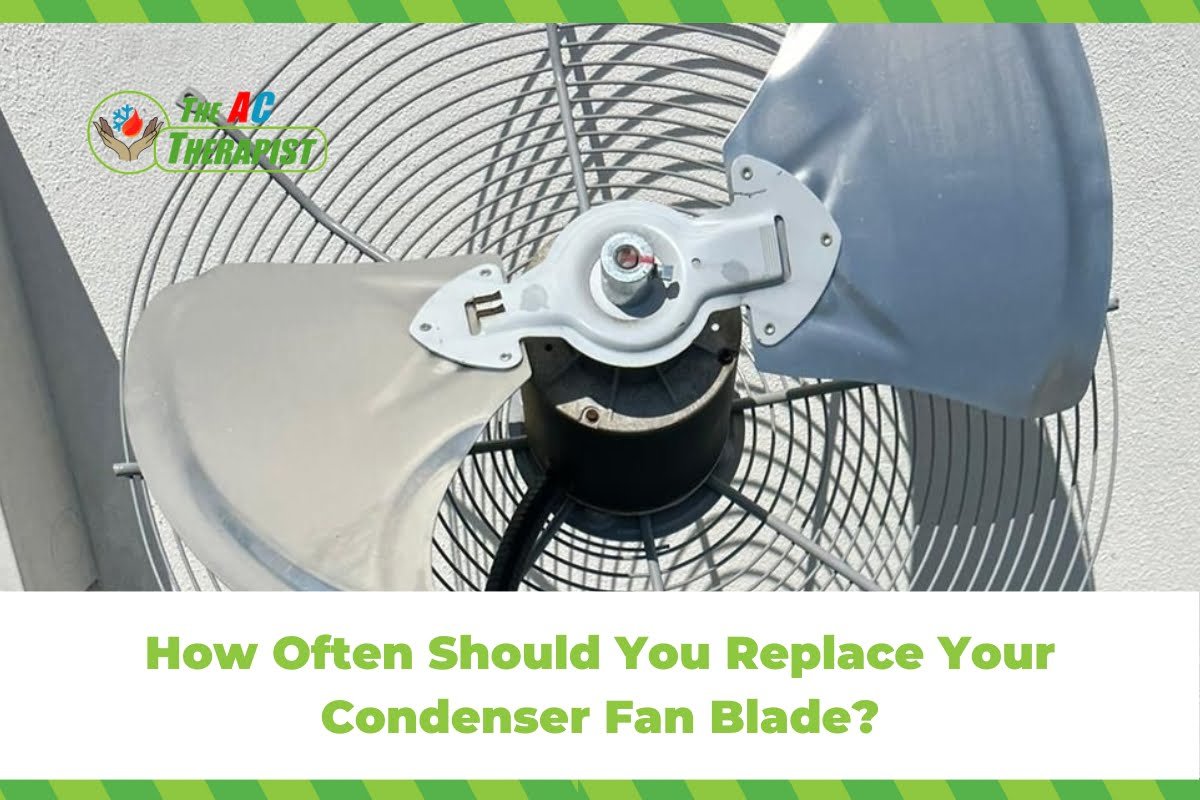How Often Should I Replace My Condenser Fan Blade?
The condenser fan blade is an essential component of your HVAC (Heating, Ventilation, and Air Conditioning) system, responsible for dissipating heat and maintaining the efficiency of your cooling system. Over time, like many mechanical parts, it can experience wear and tear. This raises an important question: How often should you replace your condenser fan blade? Enter the “5-Year Rule.”
Understanding the 5-Year Rule
The “5-Year Rule” is a guideline often recommended by HVAC professionals for assessing the condition of the condenser fan blade and considering whether it needs replacement. While it’s not a strict rule, it provides a general timeframe to keep in mind. Here’s how it works:
- Initial Inspection: When your HVAC system is around five years old, it’s a good time to start paying closer attention to the condenser fan blade. You should have it inspected as part of routine maintenance.
- Regular Maintenance: Regular maintenance is crucial for assessing the condition of the fan blade. During scheduled HVAC service, a technician will examine the blade for any signs of wear, damage, or imbalance. They will also clean the blade and its surroundings to ensure optimal performance.
- Monitoring Over Time: After the initial inspection, continue monitoring the fan blade’s condition during each maintenance visit, typically on an annual basis. If there are signs of deterioration or issues with the fan blade before it reaches five years, it may need replacement sooner.
- Replacement Consideration: By the time your HVAC system reaches the 5-year mark, you should seriously consider replacing the condenser fan blade, even if it appears to be in good condition. This proactive approach helps prevent unexpected breakdowns and ensures optimal performance.
Factors Influencing Replacement Frequency
While the 5-Year Rule provides a useful guideline, several factors can influence the actual replacement frequency of your condenser fan blade:
- Climate: Harsh weather conditions, extreme temperatures, and exposure to elements can accelerate wear and tear on the fan blade. In such cases, more frequent inspections and potential replacements may be necessary.
- Maintenance: Regular maintenance plays a significant role in prolonging the life of your condenser fan blade. Proper cleaning, lubrication, and timely repairs can extend its lifespan beyond the 5-year mark.
- Quality of Components: The quality of the fan blade and the materials used in its construction can impact its durability. High-quality blades may last longer than lower-quality alternatives.
- Usage: How often your HVAC system runs can also affect the fan blade’s lifespan. Systems that operate continuously or frequently may experience more wear on the blade.
- Visual Inspection: In addition to annual inspections, perform visual inspections periodically. Look for signs of damage, bending, or warping. If you notice any issues, don’t wait until the 5-year mark to address them.
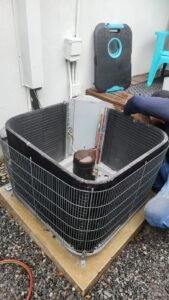
Maintenance Matters
Proper maintenance of your condenser fan blades is essential to ensure the efficiency and longevity of your HVAC system. Regular cleaning is one of the most critical maintenance tasks. Over time, dirt, dust, and debris can accumulate on the fan blades and the surrounding area. This buildup can obstruct airflow and reduce the fan’s ability to dissipate heat efficiently.
Cleaning the fan blades and the area around them can improve your HVAC system’s performance. Additionally, lubricating the fan motor’s moving parts is another maintenance task to consider. Well-lubricated components operate smoothly, reducing wear and tear and extending the lifespan of your condenser fan blades.
Maintaining your condenser fan blade is essential to ensure the efficient operation of your HVAC (Heating, Ventilation, and Air Conditioning) system. Regular maintenance can help prevent issues, improve energy efficiency, and extend the lifespan of your equipment. Here’s a step-by-step guide on how to perform condenser fan blade maintenance:
Before You Begin: Safety First
Always prioritize safety when working on your HVAC system. Turn off the power to your HVAC unit from the circuit breaker or disconnect the switch to avoid electrical hazards.
Materials You’ll Need:
- Screwdriver or wrench (for access panel removal)
- A soft brush or vacuum cleaner
- Garden hose with a spray nozzle
- Lubricating oil (if applicable)
- Safety goggles and gloves
Maintenance Steps:
- Shut Off the Power: As mentioned earlier, turn off the power to your HVAC unit to ensure your safety during maintenance.
- Access the Condenser Unit: The condenser fan blade is located in the outdoor unit, typically housed behind a metal or plastic access panel. Use a screwdriver or wrench to remove the panel carefully. Set it aside for reassembly later.
- Inspect for Debris: Examine the condenser fan blade and surrounding area for debris such as leaves, dirt, and twigs. Remove any visible debris by hand or with a soft brush. Be gentle to avoid damaging the fan blades.
- Clean the Blades: Use a vacuum cleaner with a soft brush attachment to clean the fan blades more thoroughly. Ensure all dirt and debris are removed from both sides of the blades.
- Check for Bent Blades: Inspect the fan blades for any signs of damage, such as bending or warping. If you notice any bent blades, consider replacing them as bent blades can disrupt airflow and reduce efficiency.
- Lubricate the Motor (if applicable): Some condenser fan motors require lubrication. Check your HVAC system’s user manual to determine if lubrication is needed. If so, apply a few drops of lubricating oil to the motor’s oil ports, following the manufacturer’s instructions.
- Inspect Wiring and Electrical Components: While the access panel is open, inspect the wiring and electrical components for signs of wear or damage. Look for loose connections or exposed wires and address any issues promptly.
- Reassemble and Test: After completing the maintenance tasks, carefully reattach the access panel and secure it with screws or bolts. Turn the power back on at the circuit breaker or disconnect the switch.
- Test the Fan: To ensure everything is functioning correctly, turn on your HVAC system and observe the condenser fan blade in action. Listen for any unusual noises, and verify that the fan is spinning smoothly.
- Schedule Professional Maintenance: While regular DIY maintenance is beneficial, it’s also essential to schedule annual professional HVAC maintenance. A certified technician can perform a thorough inspection, identify potential issues, and fine-tune your system for optimal performance.
By following these maintenance steps, you can help keep your condenser fan blade and the entire HVAC system in excellent working condition, ensuring efficient cooling and heating throughout the year.
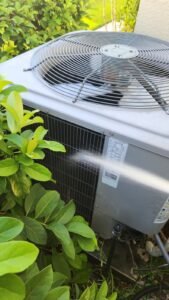
Step-by-Step Guide to Condenser Fan Blade Replacement in Your HVAC System
Replacing a condenser fan blade in your HVAC (Heating, Ventilation, and Air Conditioning) system is a task that should be done with caution and precision. Here’s a step-by-step guide on how to replace a condenser fan blade:
Before You Begin: Safety First
Always prioritize safety when working on your HVAC system. Turn off the power to your HVAC unit from the circuit breaker or disconnect switch to avoid electrical hazards.
Materials You’ll Need:
- New condenser fan blade (ensure it’s the correct size and type)
- Screwdriver or wrench (for access panel removal)
- A soft brush or vacuum cleaner
- Adjustable wrench or pliers
- Safety goggles and gloves
Replacement Steps:
- Shut Off the Power: As mentioned earlier, turn off the power to your HVAC unit at the circuit breaker or disconnect switch to ensure your safety during the replacement.
- Access the Condenser Unit: The condenser fan blade is located in the outdoor unit behind a metal or plastic access panel. Use a screwdriver or wrench to carefully remove the panel. Set it aside for reassembly later.
- Identify the Fan Motor: Locate the fan motor assembly. It is usually positioned near the center of the condenser unit and is connected to the fan blade.
- Remove the Fan Blade: The fan blade is typically attached to the fan motor with a central nut or bolt. Use an adjustable wrench or pliers to carefully loosen and remove this nut or bolt. Pay attention to the orientation of the old fan blade so that you can install the new one correctly.
- Detach the Old Fan Blade: Gently pull the old fan blade off the motor shaft. Be cautious not to damage the motor or any surrounding components during this process.
- Install the New Fan Blade: Slide the new fan blade onto the motor shaft in the same orientation as the old one. Ensure it’s securely seated.
- Secure with Nut or Bolt: Using the adjustable wrench or pliers, reattach the central nut or bolt to the motor shaft and tighten it securely. Make sure the fan blade is positioned evenly on the motor shaft.
- Inspect the Motor: While you have access to the fan motor, take a moment to inspect it for any signs of wear, damage, or loose connections. Address any issues as needed.
- Reassemble the Access Panel: Carefully reattach the access panel to the condenser unit and secure it with screws or bolts.
- Turn On the Power: Turn the power back on at the circuit breaker or disconnect the switch.
- Test the Fan: To ensure everything is functioning correctly, turn on your HVAC system and observe the new condenser fan blade in action. Listen for any unusual noises, and verify that the fan is spinning smoothly.
- Schedule Professional Inspection: After the replacement, it’s advisable to schedule a professional HVAC technician to inspect your system and ensure that the fan blade replacement has been done correctly. They can also perform any necessary adjustments or fine-tuning.
Replacing a condenser fan blade is a task that requires attention to detail and the proper tools. If you’re not comfortable with this process or have any doubts, it’s best to consult a qualified HVAC technician to perform the replacement safely and effectively.
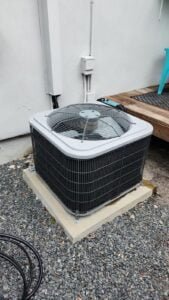
Troubleshooting Common Issues
Occasionally, you may encounter issues with your condenser fan blades. One common problem is noise. If your fan blades are producing unusual sounds, it’s essential to diagnose the cause. Noisy fan blades can result from loose components, worn-out bearings, or imbalanced blades. Addressing these issues promptly can prevent further damage and restore quiet operation to your HVAC system.
Another concerning issue is when the condenser fan blade stops spinning. This can lead to overheating of the condenser unit, potentially causing damage to other components. There are several possible reasons for this problem, including a faulty motor, capacitor issues, or electrical problems. Promptly addressing non-spinning fan blades is crucial to prevent extensive HVAC system damage.
Troubleshooting common issues with condenser fan blades in HVAC systems is essential to maintain the efficiency and functionality of your cooling system. Here are some of the most common problems you may encounter with condenser fan blades and their troubleshooting solutions:
Noisy Fan Blades:
- Issue: If you hear unusual noises, such as squealing, rattling, or banging, coming from the outdoor unit, it’s a sign of a problem with the fan blades.
- Solution: Inspect the fan blades for any debris or foreign objects that might be causing the noise. Tighten any loose components. If the noise persists, the fan motor or blades may be damaged and require replacement.
Fan Blades Not Spinning:
- Issue: If the fan blades are not spinning when the HVAC system is running, the condenser unit can overheat, leading to reduced cooling efficiency or system shutdown.
- Solution: Check the power supply to the outdoor unit. Ensure the circuit breaker or disconnect switch is on. If power is supplied, but the fan blades are not moving, the fan motor may be faulty and should be inspected by a professional technician.
Fan Blades Out of Balance:
- Issue: An imbalanced fan blade can cause excessive vibration and noise during operation.
- Solution: Inspect the fan blades for any visible signs of damage, bending, or warping. If you notice any, consider replacing the fan blade. Properly balanced fan blades are crucial for smooth operation and system longevity.
Reduced Cooling Performance:
- Issue: If your HVAC system is not cooling your space adequately, the condenser fan blades may not be dissipating heat effectively.
- Solution: Check for obstructions around the condenser unit that could block airflow. Clean the fan blades and surrounding area to remove dirt and debris. If the problem persists, the issue may be related to refrigerant levels or other system components, and you should consult a professional technician.
Fan Motor Overheating:
- Issue: Overheating of the fan motor can cause it to shut down or become less efficient.
- Solution: Ensure the fan motor is adequately lubricated, as specified in your HVAC system’s user manual. Also, check for proper voltage supply and electrical connections. If the motor continues to overheat, it may need replacement.
Uneven Cooling:
- Issue: If some areas of your home or building are cooler than others, it could indicate an airflow problem caused by a malfunctioning fan blade.
- Solution: Inspect the fan blade for damage or irregularities that might affect airflow. Ensure it’s properly installed and balanced. If the issue persists, consider professional assistance to evaluate the overall HVAC system.
Excessive Heat in the Condenser Unit:
- Issue: The condenser unit itself can become excessively hot due to problems with the fan blade, causing inefficient cooling.
- Solution: Ensure the fan blades are clean and free from debris. Check the fan motor for proper operation and inspect for signs of wear or overheating. If the issue continues, consult an HVAC technician to diagnose and resolve the problem.
Remember that while some troubleshooting can be done by homeowners, HVAC systems can be complex, and professional assistance may be necessary for more severe issues or when in doubt. Regular maintenance and inspection by a certified HVAC technician can help prevent common problems with condenser fan blades and ensure the long-term efficiency of your cooling system.
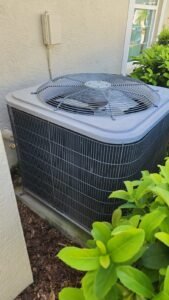
Energy Efficiency and Your Condenser Fan Blade
Energy efficiency is a top priority for modern homeowners and businesses. Your condenser fan blade plays a pivotal role in this regard. A well-maintained fan blade can reduce your HVAC system’s energy consumption. When the fan operates smoothly and efficiently, it requires less power to achieve the same level of cooling.
One notable advancement in condenser fan blade technology is the introduction of variable-speed fan blades. Unlike traditional fixed-speed blades, variable-speed blades can adjust their rotation speed based on the cooling demands. This flexibility allows your HVAC system to operate at varying capacities, consuming less energy during periods of lower cooling needs. As a result, you can enjoy lower energy bills and a reduced environmental footprint.
The AC Therapist – Your Partner for Condenser Fan Blade Replacement and HVAC Maintenance
In conclusion, the maintenance and replacement of your condenser fan blade are critical aspects of ensuring the optimal performance and longevity of your HVAC system. As we’ve explored in this blog, the “5-Year Rule” serves as a valuable guideline, reminding us to pay close attention to this crucial component as our HVAC systems age.
However, it’s essential to remember that the frequency of replacement can vary based on several factors, including climate, maintenance practices, component quality, and usage patterns. Regular inspections and maintenance by a trusted HVAC professional, such as The AC Therapist, are key to assessing the condition of your condenser fan blade accurately.
The AC Therapist, with expertise in residential and light commercial HVAC services, including condenser fan blade replacement, can provide you with the necessary guidance and support. Their technicians can conduct thorough inspections, offer recommendations, and ensure that your HVAC system operates at its best, keeping your indoor spaces comfortable year-round.
By adhering to the principles of regular maintenance, proactive assessment, and timely replacement when needed, you not only extend the life of your HVAC system but also enjoy increased energy efficiency and cost savings. So, don’t hesitate to reach out to The AC Therapist for all your HVAC maintenance and replacement needs, ensuring that your condenser fan blade and your entire HVAC system continue to serve you efficiently for years to come.

